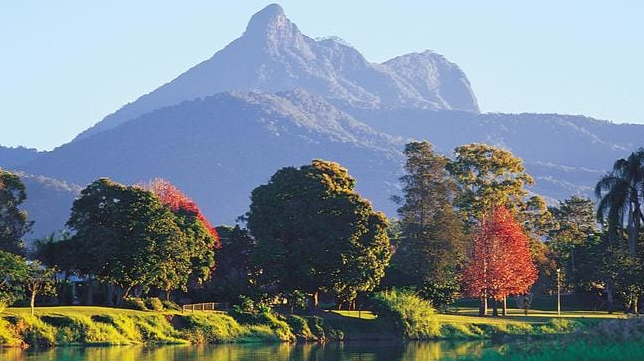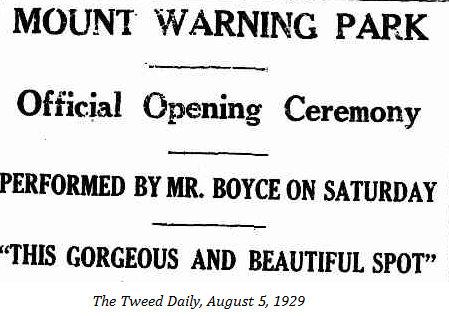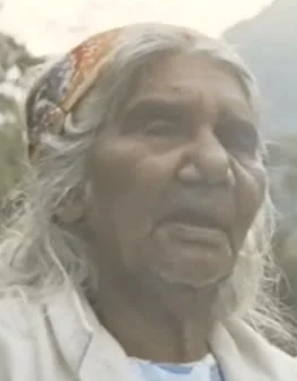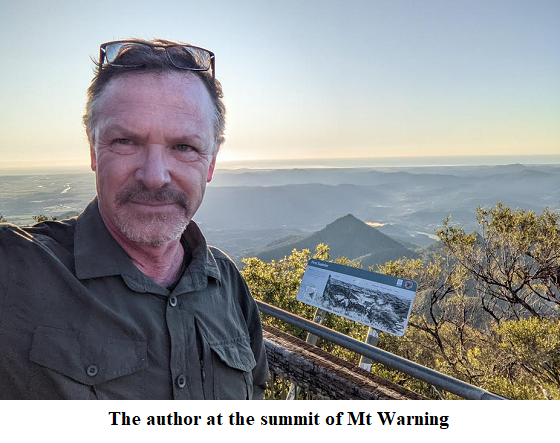
At Murwillumbah on Saturday, January 14, ardent bushwalker and Quadrant Online contributor Marc Hendrickx spoke at a community rally devoted to debating the ban on the now-denied right of non-Aborigines to ascend the summit. Below is an edited version of his speech.
_____________
Thank you all for coming today. You can all be proud of standing up in support of continued public access to this remarkable 20-million-year-old natural wonder, this grand volcanic edifice, that looks over this wonderful town and country. The underlying principle of park management should be that we are all able to enjoy the natural world on our own terms without interference from petty bureaucracy and the ideologies of others. Long established trails and walks in our parks deserve to be appropriately maintained and open to all. Those that do not want to climb or visit the park are free not to do so, but they have absolutely no right to impose their views on others seeking the awe, wonder and serenity of this outstanding natural place.
I have a shortish speech I hope will not bore you, and then if anyone else would like to lend their voice in support of reopening the park we will be happy to hear from you. If anyone here would like to say why the public should be banned from access to such awe and wonder we will hear you out. Please give me time to finish.
After the mess of the last few years, through COVID and the floods, I’m sure you’ll find many businesses will appreciate a visit. If you have suggestions for future events or future actions to help get the park re-opened please post them to the Facebook page. We welcome and need your input. I suspect that this will not be the last time we meet to call for access to our park, our mountain.
Over a century ago in 1909 the good people of Murwillumbah saw the value of their mountain, and volunteers from the town carved a track to its summit that included a set of drystone retaining walls that deserve heritage listing but have been ignored by the current park management. The track was so good you could ride a horse to the base of the rock scramble a couple of hundred meters from the top. Try doing that today along what’s become a narrow, neglected, overgrown single track. Between 1909 and 1929 the people of Murwillumbah petitioned the state government to preserve the area for posterity for all Australians, regardless of their race or religion, as a National Park.
 The park was officially opened on Saturday August 3, 1929 by the State’s Attorney-General Francis Stewart Boyce. Lucky him, he got to ride a horse almost to the summit with his wife. The ceremony was attended at the peak by over 200 people, mainly school children from Murwillumbah – they were much tougher those days. It would have been fairly crowded at the top. The Tweed Daily newspaper covered the event at the time and I’ll just read some pieces from that news story.
The park was officially opened on Saturday August 3, 1929 by the State’s Attorney-General Francis Stewart Boyce. Lucky him, he got to ride a horse almost to the summit with his wife. The ceremony was attended at the peak by over 200 people, mainly school children from Murwillumbah – they were much tougher those days. It would have been fairly crowded at the top. The Tweed Daily newspaper covered the event at the time and I’ll just read some pieces from that news story.
It mentions the opening ceremony “is another link in local history, and consummates a deep wish of many of the Tweed’s leading citizens to have the reserve dedicated for public recreation and a sanctuary for wild life of all kinds.”
Those present, aside from the state’s attorney-general included the Mayor of Murwillumbah along with councillors and other dignitaries and people from Murwillumbah and the surrounding region, including delegations from Nimbin, Lismore, Grafton and Casino. It was truly a regional event.
In his speech, as reported in the Tweed Daily, Mayor Black praised the efforts of volunteers in maintaining the track. To the many children at the summit ceremony he
urged the boys and girls to remember that the park was theirs and that each could be a trustee in his or her own little way. He said the park was a memorial of the beauty of nature and of the bountiful way in which God had blessed the Tweed and the people of Australia.
Councillor Alderman Rudd stated “The opening of the park was an historical occasion for the area would be a haven for all time, and would be famous for years to come as a tourist resort.”
Attorney-General Boyce said those who initiated and carried out the scheme to reserve the park deserved the highest compliments for their enterprise, “so this gorgeous and beautiful spot is dedicated to the people forever”. With that, the park was declared open.
Between the opening in 1929 and the early 1970s tourism in the area grew and increasing numbers of people were visiting the park, putting pressure on maintenance and parking and the summit.
In the 1970s and 80s the National Parks and Wildlife Service undertook extensive anthropological  research into parks under its control. For Mt Warning anthropologist Howard Creamer, who is still around, undertook extensive interviews with Aboriginal elders including the last “Gulgan” or keeper of Mount Warning and its tribal folklore: Millie Boyd. In her interview with Howard part of which is available on youtube, Millie Boyd (left) called Mt Warning Wulambiny Momoli. This has the meaning of ‘scrub turkey nest’, the mountain was an ‘increase site’ where hunting was forbidden so that brush turkeys could replenish their numbers.
research into parks under its control. For Mt Warning anthropologist Howard Creamer, who is still around, undertook extensive interviews with Aboriginal elders including the last “Gulgan” or keeper of Mount Warning and its tribal folklore: Millie Boyd. In her interview with Howard part of which is available on youtube, Millie Boyd (left) called Mt Warning Wulambiny Momoli. This has the meaning of ‘scrub turkey nest’, the mountain was an ‘increase site’ where hunting was forbidden so that brush turkeys could replenish their numbers.
If you look at the profile of Mt Warning from the north, you can see the Turkey sitting on its nest. It is as plain as day. No wonder this view inspired the story. In the foreground, north east of Mt Warning, according to Millie, is Wollumbin the Warrior lying on his back looking at the stars on James McKenzie’s property. Its name was stolen by NSW Lands and incorrectly applied to Millie’s T
urkey. Recently we have been told a new story about Wallumban as a place of Caterpillar Dreaming. Mt Warning has many Aboriginal names each one depicting different Dreaming lores but we are told all are connected.
Shamefully, this important cultural group with proven links to the mountain and its stories has been ignored for the past 20 years by NPWS bureaucrats. Ngaraakwal elder Marlene Boyd, daughter of Millie, worked to expose the misinformation being promulgated by NPWS. In 2007, not long before her death, she challenged the Bundjalung claims and stated: “I do not oppose the public climbing of Mt Warning. How can the public experience the spiritual significance of this land if they do not climb the summit and witness creation!”
No less shamefully, none of this wonderful mythology has made its way into current management plans for the park, including the recent Aboriginal Place Management Plan (see page 26) released last year. None of this has been provided for in signage at the base of the summit walk. Marlene Boyd’s wonderful affirmation of humanity and of what many of us seek when we bushwalk is not on a sign at the summit. Instead NPWS bureaucrats have for 20 years mislead the public about the nature of Aboriginal beliefs about the mountain and promoted the ideology of just one group, the so called Bundjalung Nation, which seeks to ban the public from the entire park. In the declaration of the area as an Aboriginal Place in 2014 we are told there are at least eight Aboriginal stories about the mountain. We are told each story is equally valid; with no one story taking precedence. How then can NPWS justify promoting just one over the others? They can’t, but they have nevertheless been getting away with it for nearly two decades, deliberately misleading government ministers and the public. I asked the NSW Ombudsman’s office to look into this wilful deception but they decline to investigate.
In Howard Creamer’s interviews with elders in the 1970s and 80s, the issue of the public climbing Mt Warning was never raised by those elders. NPWS management plans in 1985 acknowledged the importance of the mountain to Aboriginal groups but indicated there were no actual artefacts found on the mountain, stating: “There are no Aboriginal sites recorded in Mount Warning National Park although Mount Warning itself is considered by Aborigines to be of great significance.”
In the century since the track was opened the summit has been visited by millions of people, men women, children, families. They have come, like I did, as we all do, to enjoy the peaceful journey through the rainforest and experience the remarkable views of the north coast that are available from the mountain’s summit.

We climb for a multitude of reasons — for the pure joy of it, for the physical challenge, for the view. Looking out on that remarkable landscape from the summit is humbling. It provided a sense of perspective and insight of our place in this world: we are but small specks in the face of such grandeur. It shows us we are part of a bigger whole, the what we see is worth protecting, worth preserving for the future. The vast majority of those visitors have left just their footprints behind. NPWS have raised issues about waste and rubbish but these problems have been exaggerated and are easily solvable. NPWS need to look overseas at parks such as Zion National Park in Utah or the Diamond Head Walk at Waikiki in Hawaii to see how these places can be adequately managed in a way that preserves natural spaces but also provides for sustainable public access. There are easy solutions available if they just open their eyes and look around. The minister needs to get his bureaucracy working for the people, not against them.
Issues have been raised about safety along the walk and the increase in the numbers of visitors requiring rescue. Firstly, and I deal with risks like this as part of my work as an engineering geologist, the numbers are no greater than other walks of similar grade elsewhere in the state. Secondly this issue arises largely due to NPWS own mismanagement and lack of maintenance of the track. The track was built by volunteers to a very high standard in 1909, with horses able to walk almost near the summit. No one needed rescuing at the opening in 1929, before the climbing chain was in place, because the track was in such good condition. It is currently a narrow overgrown single track with areas of exposed boulders that get slippery when wet – no wonder people are twisting ankles. Many of these minor injuries could have been prevented if only NPWS had maintained the track to a suitable standard appropriate for the high level of visitation experienced since it installed the lookout platforms in the late 1980s. This was perhaps the last time NPWS undertook appropriate management of infrastructure in the park.
I contend the issues surrounding public access in the park, including to the summit, are not overwhelming and I believe a compromise that results in better management of the park for all, including the multitude of Aboriginal groups, is possible.
The current situation arises from the disgraceful neglect and mismanagement of the park by NPWS bureaucrats. Based in Sydney and Byron Bay, I suspect most NPWS bureaucrats prefer the comfort of air-conditioned offices to the exterion of the climb. They have been busy working for that last 20 years to make life easier for themselves. Since the mid 2000s, obscenely, they have been working on a “demarketing plan” to downgrade the experience of Mt Warning National Park, seeking to reduce visitor numbers. And it looks like they will soon be successful. Like some bizarre Monty Python or Yes, Prime Minister episode, we will soon see a national park that has no visitors. What easier way to manage than that? These clowns will probably laud this as the best park management in the world.
Our political leaders, especially the Premier and current minister James Griffin, have lacked the courage to call out the misinformation, the lies about safety, the exaggerations about environmental issues and misinformation about the views of Aboriginal custodians. This disgraceful situation is an example of the worst management of public lands in the history of New South Wales, if not the whole country.
I call on the Premier and Minister Griffin, and the NSW Ombudsman, to undertake an in-depth independent inquiry into the gross mismanagement of Mt Warning National Park and work to restore public access as soon as possible.
Today we gather together to celebrate the mountain’s history. To remember how good and special it was to walk to the summit with friends and family or on our own to watch the sun rise over the Pacific.
We call on the state government bureaucracy and our political leaders to work with us, the Aboriginal custodians and other stakeholders towards a solution that will see public access to the park and its summit restored so all our children and grandchildren through the ages to come can experience the same joy, awe and wonder as we have.
In 1929 Mayor Black entrusted the boys and girls at the summit to look after the park. We assembled here today are the descendants of those summit children. It is up to us to protect our legacy.
It’s time to re-open Mt Warning! Once again, let this gorgeous and beautiful spot be dedicated to all people forever.

 Sign In
Sign In 0 Items (
0 Items ( Search
Search










An excellent speech – well done.
Hopefully every MP in NSW will read it and reverse the decision.
Thank you for the article. Let’s consider the quote from the opening:
“urged the boys and girls to remember that the park was theirs and that each could be a trustee in his or her own little way. He said the park was a memorial of the beauty of nature and of the bountiful way in which God had blessed the Tweed and the people of Australia.”
1. “Boys and girls”: people don’t have children anymore and when they do they normally raise spoiled brats.
2. “Trustee”: being a trustee in your own way suggests a sense of responsibility and autonomy that doesn’t exist today. Today we live in the eternal present as consumers and the state runs our lives.
3. God? Good one.
4. “People of Australia”: if this people existed they would be up in arms about being denied access to their natural wonders.
–
Australians in the past saw the continent as their homeland, given to them by God, and developed by their forefathers. I don’t know what the majority think today but I can certainly see what the government wants you to think: if you are not an Aborigine then you are not indigenous, and are therefore an intruder.
I commend you Marc on your tenacity and professional approach to making this gathering happen.
It is hard to believe that we are supposedly living in a ‘free’ country when we are prevented from enjoying our environment.
Thank you.
The earth is the LORD’s and the fullness thereof,
The world and they that dwell therein. (Psalm 24:1, KJV)
We are thus all tenants on God’s land.
These words might or might not have been familiar to the dignitaries and others present at the opening of Mt Warning Park in 1929 but their sentiments evidently were.
Marc Hendrickx recounts the words of the Mayor of Murwillumbah: “…the park was a memorial of the beauty of nature and of the bountiful way in which God had blessed the Tweed and the people of Australia.”
Contemporary Aboriginal activists and their bureaucratic and political enablers in Byron Bay, Sydney and elsewhere bring to mind the old saying “dog in the manger” seldom heard today.
Marc, I suggest that you and your supporters should hold a memorial climb to honour the Ngaraakwal elders, Millie and Marlene Boyd.
.
You could call it the “take back the park” movement. Volunteers could start renovating the track as a people’s action and respect for elders operation.
.
People’s action, hard for a government to argue against that. If you get enough volunteers, you will see the NPWS cave in to your pressure. Take back your park.
good suggestion! we had in mind a working bee to start cleaning it up, Dedicating a walk to Marlene and Millie a great idea.